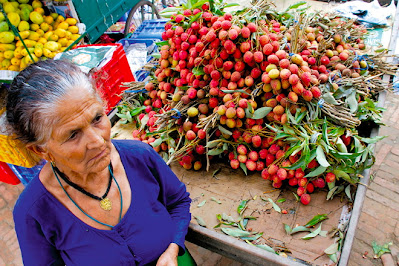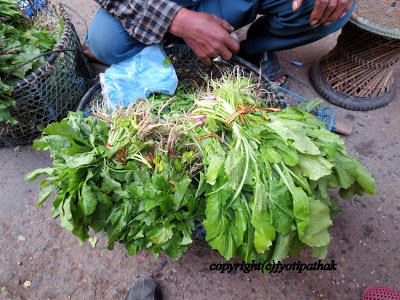The perk of being a hardworking writer, especially if you put out a good piece of work like A Killing in the Sun, is that you get to go on these fully sponsored trips. Last month, I traveled to South Africa, to attend Time of the Writer festival, in Durban, and also to be part of the Literary Crossroads at the Geothe Institute in Jo'burg. I was with the amazing Napo Masheane, in a discussion moderated by the vibrant Niq Mhlongo. I'm not a good public speaker, I often squirm in front of an audience, but the reading I had turned out to be one of the best ever, maybe because Napo and Niq made me feel comfortable and welcome.
 |
| The Jo'burg skyline, as seen from the Melville koppie |
I stayed in a quiet suburb, Melville, one of the safest places in Jo’burg. I could move around with my camera without fear of being robbed. That first day, I forgot to change money at the airport. Big mistake. I took a tuktuk to a bank. I was indeed surprised to see these in South African. They tell me they are still new, and have not been rolled out to all cities, but I’m glad they had the service in Melville, for they are so much cheaper than taxis. My driver, a Nigerian who goes by the name BB, told me that all tuktuk drivers were foreigners. I could not understand why, though he tried to explain that South Africans don't like doing the dirty work. He has lived in Jo'burg since 2001 and has suffered xenophobia and stereotyping, but he likes it there and he only goes back to Nigeria once every few years.
 |
| Sights of South Africa. Whatever art this is! |
At the bank, I realized I had made a mistake in not changing money at the airport. They asked for my passport, then for proof of residence, for my visa, and they started making phone calls, I don't know to who, and I couldn't understand what they were saying over the phone for they were speaking in their language, though I heard the bank teller spelling out my names, my date of birth, my passport number. The calls freaked me out. I only wanted to get a few rand so I could buy lunch, why was there such a fuss? I was starving. Finally, after about an hour, the teller gets a phone call, and she tells me, ‘Now everything is okay, you can get your money.’ By then, I had lost appetite. All that time just to change 50 euros?
 |
| His t-shirt reads, Not Made in China. |
Getting a simcard the next day, I thought it would be another hustle, and I was prepared for an hour of them making phone calls and reading out my name to whoever at the other end, but it was quick and easy. I guess it was just the banks being pricky (but why would they go through all that trouble when all I wanted to change was fifty euros?)
I could not go to all the attractions in Jo’burg, since I had only two free days after the reading, so I had to make choices. I could visit Mandela's home in Soweto, but I thought the Cradle of Mankind would be a better outing. I convinced my publisher, and she was so kind to take time off her busy schedule to drive me all the way to the caves. I thought we were going to a mountainside, but the caves turned out to be underground.
Experts don't think that the caves were inhabited, because it is a steep drop into the ground. They cannot imagine that homonids might have used rope ladders to get in and out. There is a certain arrogance that modern man has. He thinks he is more intelligent than his ancestors. But if homonids could control fire, if they could make stone tools, then they could make rope ladders to descend into deep holes. Ha, archeologists have no imagination. Just because they have never found fossil rope ladders doesn't mean there were no rope ladders two million years ago. I know, they use other clues to determine if a cave was inhabited, but there might have been a flood (or something) that wiped away all evidence. This is two million years ago, you know, and you need a lot of imagination to come up with what life was like in this cave. I think those guys lived in there, and had a hell of a great party. |
| The Elephant Room, a chamber in the caves. I think someone sculpted that trunk. |
There’s a lake in the caves. It has never been explored. They don’t know how deep it is. They once sent in divers, but the rope got cut, and the diver's body surfaced sixteen days later. They do not say if the body was eaten, or if some creature in the water killed him, but I wonder, why would they stop exploring the lake just because of an accident? I think they don't know what killed the diver, and I think they are afraid of what they will find in the water. Well, they claim there is nothing alive in the lake. But how can they be certain there are no living creatures in there if they don't know how deep it is? They haven't even visited all its shores, and the caves are endless. Every day, they find a new chamber. It’s an active site, with excavations going on alongside tourist visits. I think homonids still live in there, two million years later, maybe they have evolved into creatures who can only live in the dark caves (By the way, AfroSF 2 comes out soon, be sure to check out my story with pre-historic cave dwelling creatures). I say, archeologists have no imagination.
 |
| Found anything? A live excavation inside the cave. |
 |
I found the archeological museum at Maropeng to be a waste of time.
I think it was designed for children. |
After the caves, I got brave enough, and toured Jo'burg. I just couldn’t leave without seeing a bit of the city life. I went through Hillbrow, which they say was a center of resistance during apartheid, one of the few suburbs that defied segregation laws. The iconic Ponte tower was particularly of interest, for mixed-race couples lived there in those times. But it fell into disuse over the years, gangs took it over, two floors became brothels and crime hide outs. Then, it recently got refurbished, and is now one of the places to live in Jo'burg. I think that building tells the story of South Africa.
From Hillbrow, I went to Newtown. I passed scenes very similar to Kampala, bustling markets, colorful wares, music blaring from pick-up trucks in which people hawked DVDs and music CDs. It was very much Kampala without the bodabodas and striped taxis. Though just 6:30 pm, I passed a bar that was filled to capacity, with a lot of drunken people on the pavements, dancing. I wished I could take out my camera and capture it all, but my hosts had warned me not to flash expensive gadgets in the streets, for that is a sure way of attracting muggers.
 |
| Dancers perform at The Market Theater |
 Even with my camera safely hidden away in the bag, I could feel the fear in my bones, the sensation that someone would jump at me and rob me. The fear was alive in my skin, crawling through the pores like worms. I did try to ignore all the negative news I’d heard about the city, but I kept seeing signposts with ‘crime spot’ warnings, and I kept recalling this youtube clip of a live robbery, of SABC journalists getting mugged with the cameras rolling, and I thought, well, maybe Jo’burg really has a crime problem. I feared to even ask for directions, for I feared they would notice I’m a foreigner and rob me, but I got lost and I did ask for directions and I reached The Market Theater without any incident.
Even with my camera safely hidden away in the bag, I could feel the fear in my bones, the sensation that someone would jump at me and rob me. The fear was alive in my skin, crawling through the pores like worms. I did try to ignore all the negative news I’d heard about the city, but I kept seeing signposts with ‘crime spot’ warnings, and I kept recalling this youtube clip of a live robbery, of SABC journalists getting mugged with the cameras rolling, and I thought, well, maybe Jo’burg really has a crime problem. I feared to even ask for directions, for I feared they would notice I’m a foreigner and rob me, but I got lost and I did ask for directions and I reached The Market Theater without any incident.
I don’t think you’ll find this theater in many tourist guides. I recommend visiting it, especially to see a performance. It is known as South Africa’s ‘Theatre of the Struggle’, opened in 1976, the same week as the Soweto Uprisings. The founders converted an old Indian Fruit Market into three theaters, I guess that’s where it gets its name. Over the years, it staged controversial plays that tackled the inequities of the aperthied, and was one of only a few places were blacks and whites shared the stage and performed for non-racial audiences. That’s the info on the plaque outside the building.
 |
| In front of the magnificent theater. |
As I returned to my hotel in Melville, it struck me that I had just made a journey through human history. I wondered if the homonids two million years ago also struggled with issues of segregation and discrimination, and I wondered if the world would be a better place had there been no racial differences, and I wondered if two million years later there will be an utopia where our descendants live without any kind of injustice.
You Might Also Like How to Enjoy A Holiday in Nigeria Hats and Feathers: The Fashionable Men of Karamoja What I Disliked about Berlin Why I Started a Literary Magazine One thing I hate about traveling



.jpg)













Comments
Post a Comment